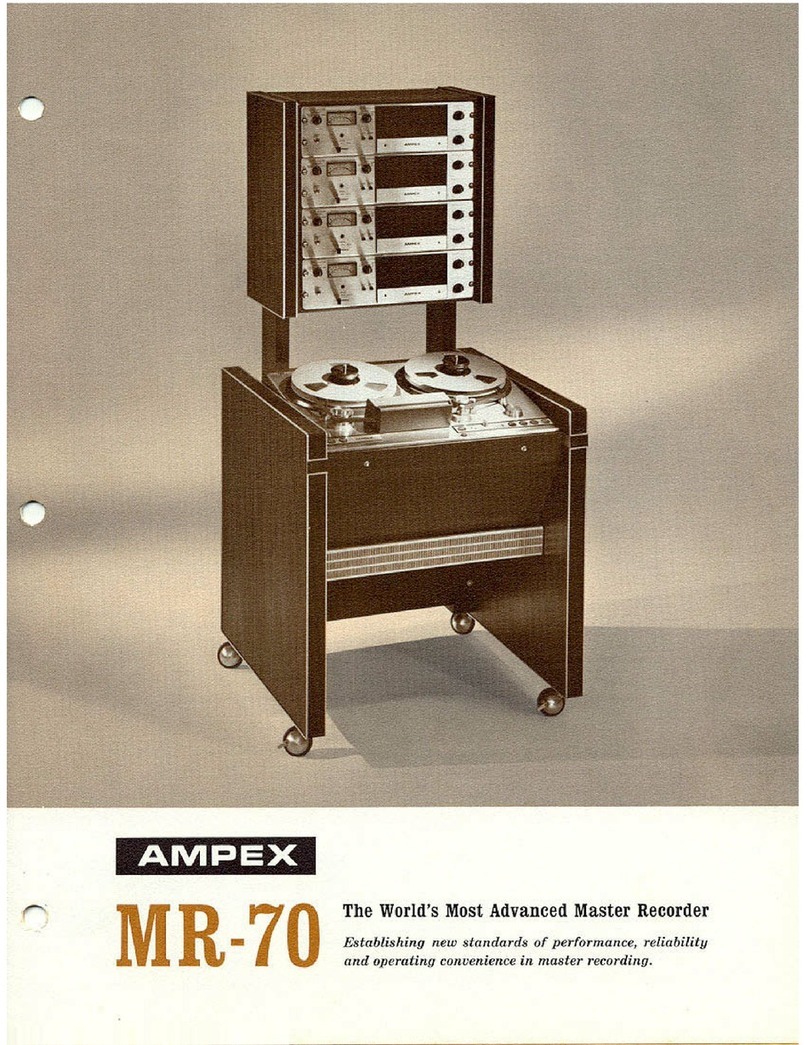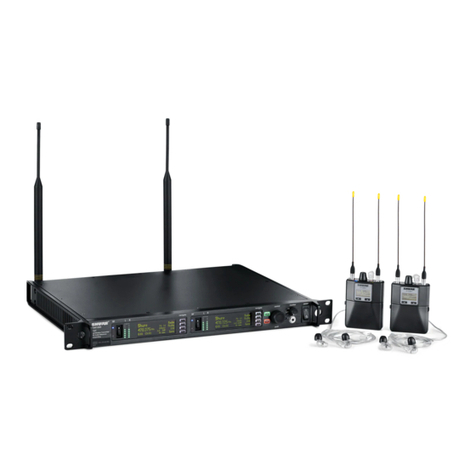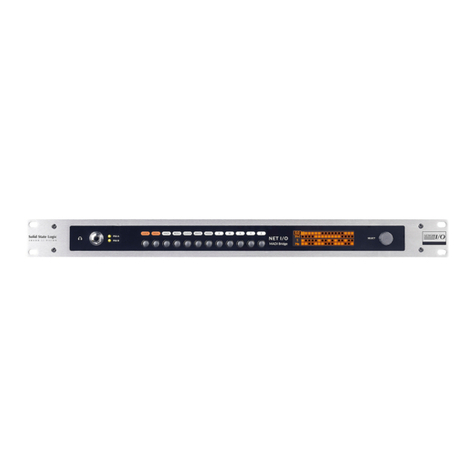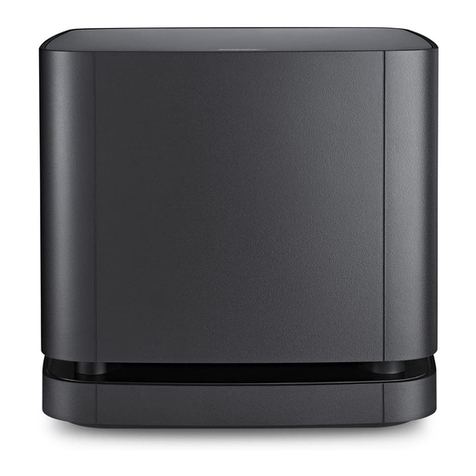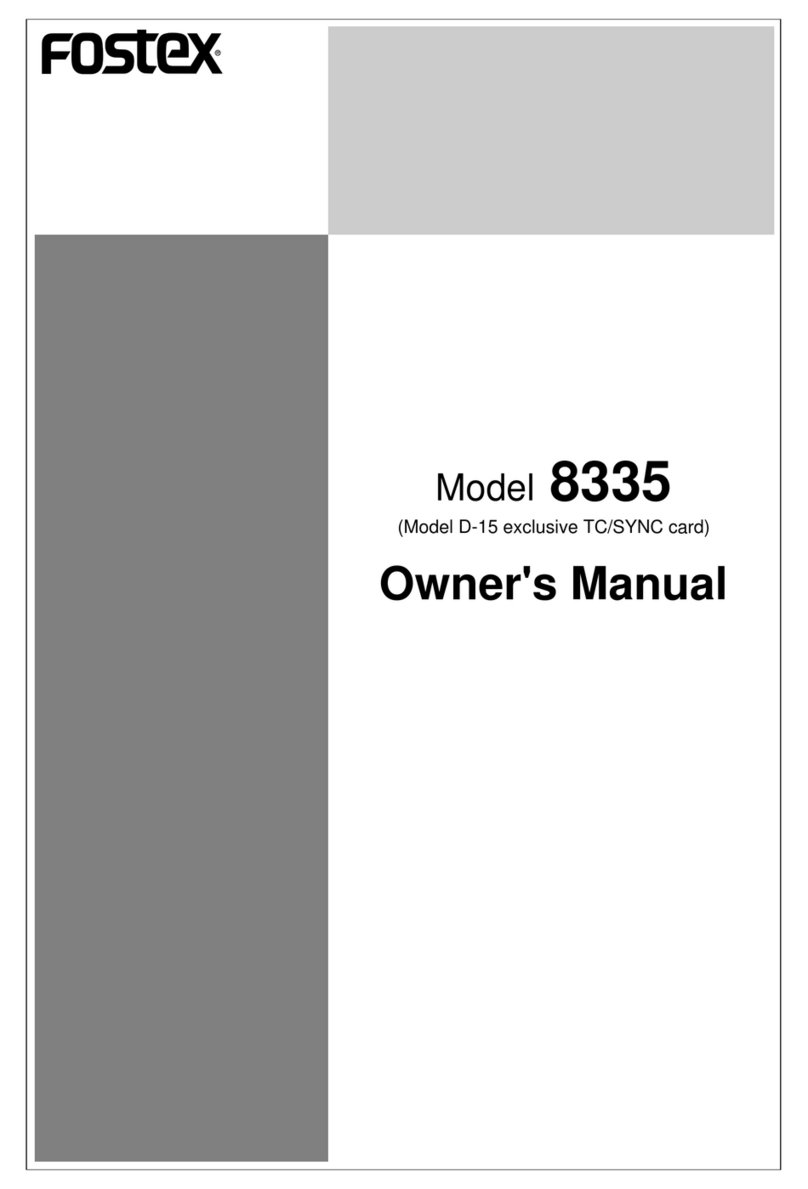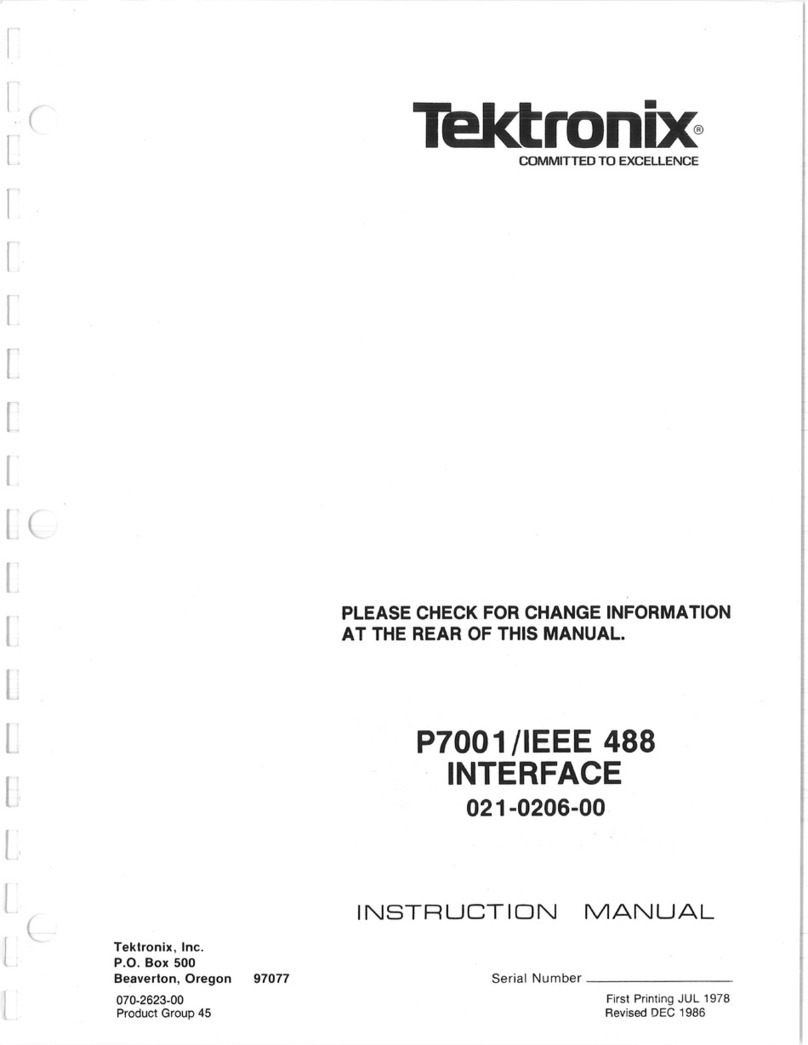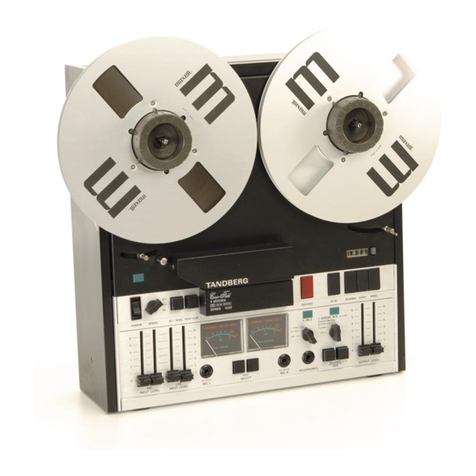Delptronics Trigger Man User manual

DELPTRONICS
Trigger Man
Trigger/Gate Sequencer
Eurorack Module
User Manual for Firmware Version 2
The most recent version of this manual can be found at http://delptronics.com/triggerman.php.

Trigger Man User ManualV2 2 of 20
Introduction
The Delptronics Trigger Man is a unique trigger/gate sequencer. There are 8 outputs and each sequence consists of
up to 8 steps per output. It has 8 pattern memories, which can be played back in any order and chained into a song
of patterns up to 100 patterns long. The revolutionary interface enables you to create and edit any pattern with
just two knobs.
Features
8 HP wide, 30mm deep
8 trigger/gate outputs
8 patterns, each consisting 8 outputs, each with its own sequence of up to 8 steps
Each output has individually configurable options:
oNumber of steps per sequence (1 to 8)
oClock divider (divide by 2, 3, or 5)
oRandomization
High or low randomization of shift or complexity
Full or weighted randomization of the sequence
oVoltage control of shift, complexity, or sequence
oTrigger/gate pulse length:
1 Millisecond
10 Milliseconds
Clock-based, output is on when clock signal is on, and off when clock signal is off
Full, output is on for the full length of the step, consecutive "on" steps produce no "off" time
between the steps
Multi-function clock input jack can be configured as:
oExternal clock ticks: In this mode, the tempo knob acts as a clock divider
oVoltage controlled tempo
oReset
oGate
Multi-function control voltage input jack can be configured as:
oVoltage controlled pattern select (in pattern play mode)
oVoltage control of complexity, shift, or sequence, configurable for each output
oReset
oGate
Three modes of operation
Algorithmic Edit: A revolutionary pattern editing interface wherein one knob controls the complexity
of the sequence (number of "on" steps and rests between the steps), and another knob shifts the
steps right and left
••• Step Edit: A traditional mode in which each step is turned on or off individually. The shift knob still
functions in Step Edit mode
∞Pattern Play: Select which pattern is currently playing, or create a chain of patterns up to 100
patterns long. The shift knob shifts the patterns in the chain
Edit a pattern while other patterns are playing
On-demand randomization: fully random, or weighted based on the current sequence
Pattern copy function
Sequence and Pattern clear functions
Internal clock with tempo knob (40 - 295 BPM)
Run/Stop button controls the internal clock, or resets to the first step if using an external clock
Non-volatile pattern and configuration memory. Data is saved even when powered off

Trigger Man User ManualV2 3 of 20
Terminology
Sequences and Patterns
The terms sequence and pattern are used very specifically in this manual, so it is important to
understand the distinction.
A sequence is a set of up to 8 steps. Each output jack has its own sequence of up to 8 steps.
A pattern is a set of 8 sequences. Think of it as an 8 by 8 grid, with steps in the X axis and the outputs in
the Y axis –just like the Step and Output LEDs on the panel. The step LEDs show the sequence for one
output at a time, and one of the output LEDs is illuminated to show the output being edited. There are 8
separate pattern memories.
Controls, Jacks, and LEDs
This manual refers to the controls, jacks and LEDs by the names shown below.
Clock Control
1 2 3 4 5 6 7 8
40
÷1
70
÷2
105
÷3
170 ÷6
200
÷8
230
÷12
295
÷32
135
÷4
265
÷16
Output
Tempo
Step LEDs
Knob 1
Knob 2
Output LEDs
Output Jacks
Tempo/Divider Knob
Start/Stop and Mode Buttons
Clock and Mode LEDs
Clock and Control Jacks

Trigger Man User ManualV2 4 of 20
Controls
Knob 1 and Knob 2
The two knobs perform various functions depending on what mode the module is in. They do not have
an indicator line on them because they are not positional. They rotate infinitely in both directions and
do not stop like a potentiometer does. They are called rotary encoders. Think of them as rotary switches
that are turned clockwise or counter (anti) clockwise to change the value of a parameter.
The knobs are also pushbutton switches. They can be pressed just like a button. They operate very much
like the volume control in most modern car radios.
Tempo/Divider Knob
The Tempo knob sets the speed of the internal clock. It goes from 40 to 295 BPM (beats per minute).
When the clock jack is configured as an external clock, the Tempo knob divides (slows down) the
incoming clock signal. The divisions are marked on the control panel.
Start/Stop Button
Pressing the Start/Stop button starts or stops the internal clock. The clock stops immediately on
whatever step was playing. When the clock restarts, it starts on the first step. The Clock LED below the
Start/Stop button blinks in time with the clock.
Note that the Start/Stop button acts differently when using an external clock signal plugged into the
Clock jack. See the Configuration section for details.
Mode Button
Pressing the Mode Button changes the current mode. Repeatedly pressing and releasing the Mode
Button cycles through the three main modes (Algorithmic, Step Edit, and Pattern Play). One of the Mode
LEDs is illuminated to indicate the current mode.
The mode button is also used to enter and exit the Copy, Action, and Configuration modes which are
described in detail later in this manual.
Action: Press and hold the Mode button while turning/pressing knobs.
Configuration: Hold the Mode button, then press the Start button, then release both buttons.
Copy: Press Knob 1 and Knob 2 at the same time, then release both knobs.
Clock and Control Jacks
The behavior of the Clock and Control jacks is set in Configuration mode. See the Configuration mode
section for full details. Control voltages into the Control or Clock jacks are expected to be 0 to 5 volts.

Trigger Man User ManualV2 5 of 20
Quick Reference
To cram a zillion functions into 8 HP, some of the controls and LEDs perform different functions or have
different meanings depending on the mode of operation. The control scheme is quite intuitive and easy
to master. The chart below summarizes the functions of the controls and LEDs for each mode, along
with a summary of the configuration options.
There is a single page version of the quick reference that also includes the annotated diagram of the
module similar to page 3 of this manual. A copy of the single page quick reference is included with the
module and can be downloaded from: http://delptronics.com/documents/TriggerManQuickRef.pdf
You may find it useful to keep the quick reference handy while learning the features of the Trigger Man.

Trigger Man User ManualV2 6 of 20
Algorithmic Mode
In Algorithmic Mode, the Step LEDs at the top of the module show the sequence of on and off steps for
one output jack at a time. An illuminated LED corresponds to +12 volts on the output jack for that step.
An off LED represents a rest where the output jack is zero volts (grounded). One of the Output LEDs on
the right side of the module is illuminated to indicate which output sequence is currently being edited.
One of the most unique features of the Trigger Man is the concept of Complexity and Shift.
Complexity is the term we use to describe the number of on steps and the rests between them.
Mathematically, there are 256 different sequences possible in eight steps, including all steps on and all
steps off. However, most of those sequences are simply shifted versions of other sequences. For
example, a sequence of one beat and seven rests can be shifted to the right to produce one rest, one
beat, then six rests. It is still the same sequence, it just starts on a different step. With an eight step
sequence, there are only 36 unique sequences; that is, 36 levels of complexity.
Turn Knob 1 to increase or decrease the complexity of the sequence.
For example:
Less Complex Less Complex Starting Steps More Complex More Complex
Turn Knob 2 to shift the steps to the right or left. For example:
Shifted Left Twice Shifted Left Once Starting Steps Shifted Right Once Shifted Right Twice
Press Knob 1 to select the previous output. The Output LED indicating the output sequence being edited
will move up one position.
Press Knob 2 to select the next output. The Output LED indicating the output sequence being edited will
move down one position.
••• Step Edit Mode
Step Edit Mode offers a more traditional editing method in which each step is turned on or off
individually. The controls in Step Edit Mode are nearly identical to Algorithmic mode. All of the controls
work exactly the same, with the exception of Knob 1.
Turn Knob 1 to move the blinking cursor to the left or right.
Press Knob 1 to toggle the step indicated by the cursor. That is, if the step was on, pressing Knob 1 turns
the step off, and if the step was off, pressing Knob 1 turns it on.
TLDR
There are tons of features described in this manual. However, what you have read so far is enough
information to start using and enjoying the Trigger Man. If you want, you can pause here and read the
rest of the manual later.

Trigger Man User ManualV2 7 of 20
∞Pattern Play Mode
In Pattern Play mode you can select which pattern is currently playing, or create a chain of patterns. A
chain is a sequence of patterns. Chains can be as complex as you want, and up to 100 patterns long. For
example, if the chain consisted of patterns 1 and 2, then those two patterns would play, one after
another repeatedly. Patterns can also appear more than once or be repeated in the chain. For example a
chain consisting of three different patterns could be 1, 1, 2, 2, 3. In that example, after pattern 3
finishes, the chain will restart and repeat.
The Step LEDs show which pattern(s) are playing. It also shows a blinking cursor. The Output LEDs are
not used in this mode, except that they (optionally) blink to indicate a trigger occurring on an output.
Turn Knob 1 to move the blinking cursor to the left or right.
Turn Knob 2 to shift the pattern or chain to the right or left. For example, a chain consisting of pattern 1
and pattern 2 is playing, and Knob 2 is turned one click to the right, then the chain will now consist of
pattern 2 and pattern 3.
Press Knob 1 to add a pattern to the chain. For example, if only pattern 1 is playing, and the cursor is on
pattern 2, then pressing Knob 1 will add pattern 2 to the chain. Pressing Knob 1 again will add a second
instance of pattern 2 to the chain, which will now play pattern 1 once, and pattern 2 twice before
repeating.
Press Knob 2 to select a single pattern to play. If a chain of patterns was previously programmed, then
the chain is erased and only the newly selected pattern will play repeatedly.
The Chain Keeps Playing
When a chain of patterns is selected, the chain keeps playing when the module is switched to
Algorithmic or Step Edit mode. You can even be editing the sequence for a pattern that is not part of the
chain. It is important to keep that in mind because, in that situation, changes to the current output will
not be immediately audible.
A chain that is one pattern long is not considered a chain at all. In that case, when the module is in
Algorithmic or Step Edit mode, and you switch to a different pattern, that new pattern will play. In other
words, with no chain, what you edit is what you hear. This fact makes it easy to ignore the whole chain
concept until you are ready to dive into it.

Trigger Man User ManualV2 8 of 20
Copy Mode
Any pattern can be copied to any other pattern. Copy mode is available from Algorithmic, Step Edit, or
Pattern Play mode, but not when the module is in Configuration or Action mode.
To access Copy mode, press both knobs at the same time, then release both knobs. The knobs do not
have to be pressed exactly simultaneously. You can press and hold Knob 1 then press Knob 2, or press
and hold Knob 2 then press Knob 1. The Mode LEDs will flash in a distinctive way to indicate that the
module is in Copy mode.
While the module is in Copy mode, the Step LEDs indicate which pattern to copy from, and which
pattern to copy to. We will call them the source pattern and the destination pattern. The source pattern
is indicated by a steadily lit LED. The destination pattern is indicated by a blinking LED.
If only one LED is illuminated, and it is blinking, then that means that the source and destination
patterns are the same. Performing the copy in that case will have no effect.
Turn Knob 1 to select the source pattern.
Turn Knob 2 to select the destination pattern.
Press Knob 1 or 2 to perform the copy. The destination pattern then becomes the current pattern. The
module returns to the mode it was in when the copy mode was initiated.
Press the Mode Button to cancel without copying anything.

Trigger Man User ManualV2 9 of 20
Action Mode
Hold the Mode Button down while pressing or turning Knob 1 or Knob 2 to perform special actions.
Action Mode is available from Algorithmic, Step Edit, or Pattern Play mode, but not when the module is
in Configuration or Copy mode.
Set Sequence Length
Hold Mode & Turn Knob 1 to set the length of the sequence for the current output. Any length from
one to eight steps can be selected. The Sequence LEDs indicate the current sequence length.
Each output can have a different sequence length. Once the sequence length is set, that will be its
length for every pattern. For example, if output 1 has a sequence length of 6 steps, then its length will
be 6 steps for pattern 1, and 6 steps for pattern 2, and 3, and so on. Until you change the sequence
length for an output, the length will remain the same for the output in every pattern.
Randomize Sequence
Hold Mode & Press Knob 1 Once to lightly randomize the current sequence. It takes the current
sequence and mixes it up just a little. Some of the steps may change from on to off, or from off to on.
There is a 1 in 8 (12.5%) chance that any given step will change. There is even a chance that none of the
steps will change. This function can also be called low or weighted randomization.
Hold Mode & Press Knob 1 Twice to generate a completely new random sequence. The current
sequence does not affect the new sequence at all.
If the current output is configured as randomized or voltage controlled (in Configuration mode), then
pressing Knob 1 once in Action mode will freeze the sequence where it is. To make the output
randomized or voltage controlled again, go to Configuration mode. The freeze feature is useful when the
random or voltage controlled sequence is pleasing, and you want to keep it.
Select Pattern
Hold Mode & Turn Knob 2 to select the pattern to edit. This changes the whole pattern (set of eight
outputs) being edited, not just the current output within a pattern. The current pattern is indicated by a
blinking Output LED which moves as Knob 2 is turned. The current output is indicated by a steadily
illuminated Output LED, as it always is in Algorithmic and Step Edit mode. If there is only one LED
illuminated, then the pattern number and output number are the same.
Clear
Hold Mode & Press Knob 2 Once to clear the sequence for the current output. All of the steps for the
current output being edited will be turned off.
Hold Mode & Press Knob 2 Twice to clear the entire pattern. All of the steps for all eight outputs will be
turned off. There is no way to clear all eight patterns at once. To clear all patterns, turn Knob 2 to select
a pattern, press Knob 2 twice to clear that pattern, and repeat eight times.

Trigger Man User ManualV2 10 of 20
Configuration Mode
Configuration mode is used to set various options for the eight Output jacks and the Clock and Control
input jacks. The Step LEDs display the state of the configurable options.
Entering Configuration Mode
Enter Configuration mode by holding down the Mode button, then pressing the Start/Stop button, then
releasing both buttons. The mode indicator LED will blink, indicating that the module is in Configuration
mode. Press and release the Mode button to exit Configuration mode. The configuration is saved when
Configuration mode is exited, and is retained even when the power is off.
Changing the Configuration
The Step LEDs show the state of the configurable options. Turning the LEDs on and off changes the
options.
One Output LED will be illuminated to indicate the output currently being configured.
Turn Knob 1 to move a blinking cursor left and right across the Step LEDs.
Press Knob 1 to toggle the configuration option indicated by the cursor. That is, if the LED (and the
corresponding option) was on, pressing Knob 1 turns that option off, and if it was off, pressing Knob 1
turns it on.
Turn Knob 2 to change the output currently being configured. The corresponding Output LED will be
illuminated.
Press Knob 2 to toggle between configuring inputs or outputs. When configuring the inputs, all eight
Output LEDs will be illuminated.
The following pages describe each configuration option in detail. Once you are familiar with the options,
you can refer to the quick reference for a reminder of which LED corresponds to which option.
In the descriptions below, a filled circle represents an illuminated LED, and an empty circle
represents an LED that is off.

Trigger Man User ManualV2 11 of 20
Output Jack Configuration Options
Each of the eight outputs has its own separate set of configuration options. Just like sequence length, all
of the options described below affect the output in all patterns. For example, if the output length is set
to 10ms, then it is 10ms in every pattern.
Output Length
LEDs 1 and 2 set the length, or pulse width, of the output trigger/gate. Output length is the length of
time that the output jack is on.
12
Clock-based Gate: The output is on when clock signal is on, and off when clock signal is off. If
using an external clock divided by 1, then the output will have the same pulse width as the
external clock. Dividing the clock by anything but 1 has the effect of squaring the external pulses
(equal on/off time). The internal clock is always square.
1 MS Trigger: The output is on for a 1 millisecond trigger pulse regardless of the clock speed or
the pulse width of the external clock.
10 MS Trigger: The output is on for a 10 millisecond trigger pulse regardless of the clock speed or
the pulse width of the external clock.
Full Gate: The output is on for the full length of the step. Additionally, consecutive on steps
produce no off time between the steps. For example, suppose the clock ticks every two seconds.
The clock is on for one second and off for one second. An output using a clock-based gate will be
on and off at the same time as the clock. An output using a full gate will be on for a full two
seconds. After that, it will only go off if the next step is off. If the next step is on, then the output
will remain on for four seconds, two full clock cycles.
Modification Parameter
The complexity, shift, or the whole sequence can be modified by randomization or voltage control. LEDs
3 and 4 set the parameter that will be modified by the modifier.
34
None: There is no modification of the sequence. It is set by the Complexity and Shift knobs.
Complexity: The complexity is randomized or voltage controlled. The shift is set with Knob 2.
Shift: The shift is randomized or voltage controlled. The complexity is set with Knob 1.
Sequence: The entire sequence is randomized or voltage controlled. The Complexity and Shift
knobs will not affect the sequence.

Trigger Man User ManualV2 12 of 20
Modifier
LEDs 5 and 6 determine how the complexity, shift, or sequence will be modified.
56
Randomize Low: When modifying the sequence, this option works just like the on-demand low
randomization in Action Mode (hold Mode and press Knob 1 once).
When modifying complexity or shift, the effect is like randomly turning the complexity or shift
knob one click to the right or left. There is a 50% chance that the sequence will not change.
There is a 25% chance that it will change by one click to the right, and a 25% chance that it will
change by one click to the left. Applying this modification to complexity results in a slowly
morphing sequence. Applying it to shift creates a meandering effect.
Randomize High: When modifying the sequence, this option works just like the on-demand high
randomization in Action Mode (hold Mode and press Knob 1 twice). A totally new random
sequence is generated each time the sequence is played.
When modifying the complexity or shift, the effect is like randomly turning the complexity or
shift knobs a few clicks in either direction. There is a 25% chance that the sequence will not
change. If it does change, there is an equal chance that the shift or complexity will change by 1, 2,
or 3 clicks to either the right or left.
VC On First Step: Voltage Control-based changes to the shift, complexity, or sequence will occur
on the first step of the sequence. Control voltage changes during the playing of the sequence are
ignored.
VC Immediate: The shift, complexity, or sequence will change immediately in response to the
voltage on the Control jack. This option can sound very different from VC changes on the first
step.
Clock Divider
LEDs 7 and 8 set the clock divisor for each output. This option works with either the internal clock or an
external clock.
78
1:1: One-to-one ratio. The clock is not divided. The clock for the output will be the same as the
master clock.
÷ 2: The master clock is divided by 2 for the output. The sequence will not advance to the next
step until two clock ticks are received. This is the equivalent of having a 16 beat pattern, although
only the odd numbered steps can be turned on.
÷ 3: The master clock is divided by 3.
÷ 5: The master clock is divided by 5.

Trigger Man User ManualV2 13 of 20
More about Voltage Control
The Control or Clock jacks are expecting control voltages to be 0 to 5 volts. The jacks are protected from
over-voltages and negative voltages, but anything over 5 volts is considered 5 volts and any negative
voltage is considered 0 volts.
To interpret the incoming control voltage, the Trigger Man divides the 5V range into equal sized steps
depending on the parameter being modified.
For example, if an output is 8 steps long, then it has 8 possible values for shift, 36 possible values for
complexity, and 256 possible values for the whole sequence. An output that is 7 steps long has
maximum values for shift, complexity, and sequence of 7, 20, and 128 respectively. It is not necessary
for a user to know these numbers. The Trigger Man knows them and will do all of the required math.
When voltage controlling shift or complexity, a control voltage of 0.5V or less is has no effect, just as if
the option was turned off or nothing was plugged into the control jack. The Remaining 4.5V range is
divided into equal sized steps depending on the parameter being modified.
When voltage controlling the sequence, the entire 5V range is used. If nothing is plugged into the
Control jack, then the all steps will remain off for that output (because the input voltage is always 0V).
Mathematically inclined users should note that, when voltage controlling the sequence, the sequence is
not set to the binary equivalent of the voltage, but rather all of the possible sequences are sorted in
ascending complexity and shift order. Stated another way, a slowly increasing voltage has the same
effect as turning the complexity knob one click, then turning the shift knob through each of the shift
values, then turning the complexity knob another click, and so on.

Trigger Man User ManualV2 14 of 20
Input Jack Configuration Options
The input jack configuration options control the function of the Clock and Control jacks, and the LED
blinking. The input options are independent of the options for the eight individual outputs.
Clock Jack Function
LEDs 1 and 2 determine the function of the Clock input jack.
12
Clock Ticks: The Clock jack expects a typical clock signal. Hysteresis occurs at 2.5 volts. That is,
when the voltage on the jack rises above 2.5 volts, it is considered on, and when it drops below
2.5 volts, it is considered off. Any waveform of any pulse width can be used to clock the Trigger
Man, including, but not limited to square, triangle, and saw tooth waves. More complex
waveforms may give unpredictable and interesting results as they pass through the 2.5 volt
hysteresis point. As soon as an external tick is received, the Trigger Man switches over to expect
an external clock signal, and the internal clock is turned off.
When receiving external clock signals, the Tempo knob acts as a clock divider. The external clock
is divided by 1, 2, 3, 4, 6, 8, 12, 16, or 32 as indicated on the panel. When the Tempo knob is
turned all the way to the left, then the module will be clocked at the same rate as the incoming
clock signal (divided by 1).
When receiving external clock signals, pressing the Start/Stop button works as a reset. After an
external tick is received the Trigger Man is “running.” At that point, pressing Start/Stop resets the
Trigger Man to the first step, and it is not considered to be running. Pressing Start/Stop again will
then restart the internal clock, which will continue to run until Start/Stop is pressed again, or an
external tick is received.
Voltage Controlled Tempo: The Clock jack is expecting zero to 5 volts, which will produce a clock
rate of 40 to 295 BPM, just like the Tempo knob does. A voltage over 5 volts is interpreted as 295
BPM. If the Clock jack function is set to voltage controlled tempo, and nothing is plugged into the
jack, the tempo will always be 40 BPM. When the Clock jack function is set to VC Tempo, the
Tempo knob has no effect. VC Tempo sets the speed of the internal clock, which is not the same
thing as external clock ticks. The Start/Stop button functions normally with the VC Tempo option.
Reset: When a positive pulse of 2.5V or higher is input into the Clock jack, the sequence will be
reset to the first step.
Gate: When zero volts is input into the Clock jack, the internal clock is paused. When 2.5V or
higher is input into the Clock jack, the internal clock will run normally. If the Gate option is set
and nothing is plugged into the Clock jack, then the internal clock will be constantly gated and
will not run. If both the Clock and Control jacks are set to Gate, then both of them must have a
positive voltage in order for the internal clock to run.

Trigger Man User ManualV2 15 of 20
Clock Jack VC Tempo Change
LED 3 determines when the tempo changes if the tempo is voltage controlled.
3
On First Step: The tempo, as determined by the voltage on the Clock jack, changes on the first
step. Voltage changes during the playing of the sequence do not change the tempo.
Immediate: The tempo changes immediately in response to the voltage on the Clock jack. Using
an LFO for the voltage controlled tempo with the Immediate change option will produce a swing
effect.
Control Jack Function
LEDs 4 and 5 determine the function of the Control input jack.
45
VC C/S/Pattern: Voltage control of complexity, shift, pattern. This option functions differently
depending on the mode. In Algorithmic or Step Edit mode, the voltage into the Control jack will
modify the complexity and/or shift of any outputs that are configured for voltage control.
In Pattern Play mode, the voltage on the Control jack sets the currently playing pattern. The 5
volt range is divided into 9 equal divisions of approximately 0.55 volts. A voltage under 0.55 volts
has no effect on the currently playing pattern, just as if nothing was plugged into the control jack.
The other 8 divisions represent one of the 8 patterns.
VC C/S Only: Voltage control of complexity or shift only. This setting works similarly to the VC
C/S/Pattern option described above, with one difference. In pattern play mode, the Control jack
does not control the currently playing pattern. It controls the complexity and shift of the outputs
for whatever patterns you have selected.
Reset: When a positive pulse of 2.5V or higher is input into the Control jack, the sequence will be
reset to the first step.
Gate: When zero volts is input into the Control jack, the internal clock is paused. When 2.5V or
higher is input into the Control jack, the internal clock will run normally. If the Gate option is set
and nothing is plugged into the Control jack, then the internal clock will be constantly gated and
will not run. If both the Clock and Control jacks are set to Gate, then both of them must have a
positive voltage in order for the internal clock to run.

Trigger Man User ManualV2 16 of 20
Control Jack VC Pattern Change
LED 6 determines when the pattern changes if the Control jack is set to VC C/S/Pattern and the module
is in Pattern Play mode.
6
On First Step: The currently playing pattern, as determined by the voltage on the Control jack,
changes on the first step. Voltage changes during the playing of the sequence are ignored.
Immediate: The currently playing pattern changes immediately in response to the voltage on the
Control jack. The current step does not reset to the first step when that happens, the pattern
changes right away. Immediate changes to the currently playing pattern can produce chaotic
results, which may or may not be desirable.
Current Step LED Blink
7
Off: The currently playing step will not be indicated by the Step LEDs.
On: The currently playing step is indicated by a blink of the corresponding Step LED. If the LED is
off, it will briefly blink on. If the LED is on, it will briefly blink off. Some users find the step blink
distracting, while others find that it provides valuable information.
Output LED Blink
8
Off: The Output LEDs will not blink.
On: The Output LEDs will blink when there is a trigger/gate signal on the corresponding jack. If
the LED is off, it will briefly blink on. If the LED is on, it will briefly blink off. Some users find the
output blink distracting, while others think that it looks cool.

Trigger Man User ManualV2 17 of 20
Saving Data
The Trigger Man has nonvolatile memory which saves the configuration and patterns even when
powered off.
Changes to the configuration are saved upon exiting Configuration mode.
Changes to the sequence length are saved upon exiting Action mode.
Changes to the sequences/patterns are saved any time the Start/Stop or Mode buttons are pressed, or
when changing the pattern being edited. Saving constantly whenever the steps changed would
introduce delays and would shorten the life of the nonvolatile memory.
Resetting Configuration Data
The Trigger Man configuration can easily be reset to factory defaults. If the module is acting in an
unexpected way, it is probably because a bunch of miscellaneous options have been set. A reset will
restore it to basic operation with all configuration options turned off except LED blinking.
To perform a reset, hold down the Start/Stop Button when you power on the module. All three mode
LEDs will be illuminated to indicate that the reset has happened. Release the Start/Stop button, and the
module will function as normal.
Only the configuration data is reset. The sequences/patterns will not be affected by a reset.

Trigger Man User ManualV2 18 of 20
Mixing Sequence Lengths
Each output can have a different sequence length. It bears repeating that an output’s sequence length is
the same for all patterns. For example, if output 1 has a sequence length of 6 steps, then its length will
be 6 steps for pattern 1, and 6 steps for pattern 2, and 3, and so on.
If all of the outputs have the same sequence length, then they all move in sync with one another. Each
output begins and ends at the same time. This is true when playing a single pattern, or a chain of
patterns. However, if some of the outputs have different sequence lengths, then things get more
complicated, and much more musically interesting. The different length sequences play different
numbers of times before everything repeats. We refer to the number of beats until the whole thing
repeats as a meta-pattern.
Playing a Single Pattern with Different Sequence Lengths
The chart below shows what happens when a single pattern is repeated with each output set to a
different sequence length.
Each cell in the chart shows the step number that is played. To highlight the point at which the
sequences reset to their first step, the sequences are shaded gray every other time they play.
The left column is the number of steps in the sequence. The top row is the beat number.
1
2
3
4
5
6
7
8
9
10
11
12
13
14
15
16
17
18
19
20
21
22
23
24
25
26
27
28
29
30
31
32
8
1
2
3
4
5
6
7
8
1
2
3
4
5
6
7
8
1
2
3
4
5
6
7
8
1
2
3
4
5
6
7
8
7
1
2
3
4
5
6
7
1
2
3
4
5
6
7
1
2
3
4
5
6
7
1
2
3
4
5
6
7
1
2
3
4
6
1
2
3
4
5
6
1
2
3
4
5
6
1
2
3
4
5
6
1
2
3
4
5
6
1
2
3
4
5
6
1
2
5
1
2
3
4
5
1
2
3
4
5
1
2
3
4
5
1
2
3
4
5
1
2
3
4
5
1
2
3
4
5
1
2
4
1
2
3
4
1
2
3
4
1
2
3
4
1
2
3
4
1
2
3
4
1
2
3
4
1
2
3
4
1
2
3
4
3
1
2
3
1
2
3
1
2
3
1
2
3
1
2
3
1
2
3
1
2
3
1
2
3
1
2
3
1
2
3
1
2
2
1
2
1
2
1
2
1
2
1
2
1
2
1
2
1
2
1
2
1
2
1
2
1
2
1
2
1
2
1
2
1
2
1
1
1
1
1
1
1
1
1
1
1
1
1
1
1
1
1
1
1
1
1
1
1
1
1
1
1
1
1
1
1
1
1
Each sequence plays out to its full length, then starts over again at step one. The different sequence
lengths reset to step 1 on a different beat. While the 8-step sequence is playing step 8, the 7-step
sequence has reset to step 1, and the 6-step sequence is already on step 2.
The point at which the meta-pattern repeats is determined by the least common denominator of the
sequence lengths. For example, a mix of 8 and 6-step sequence lengths will repeat after 24 beats. That
is three cycles of the 8-step sequence and four cycles of the 6-step sequence. This concept is illustrated
in the above chart, where you can see that all but the 5 and 7-step sequences reset to step 1 on beat 25.
Some combinations of sequence lengths can sound arrhythmic. An 8-step sequence and a 7-step
sequence repeat every 56 beats, but they do not quite sound right together. Having said that, feel free
to experiment!

Trigger Man User ManualV2 19 of 20
Playing a Chain of Patterns with Different Sequence Lengths
When the Trigger Man plays a chain of patterns that contains outputs of different sequence lengths, the
meta-patterns get longer. The chart below shows a 2-pattern chain with several sequence lengths. We
have limited the number of sequence lengths in the chart for clarity.
The cells in the chart contain the pattern number and the step number separated by a dot.
1
2
3
4
5
6
7
8
9
10
11
12
13
14
15
16
17
18
19
20
21
22
23
24
25
26
27
28
29
30
31
32
8
1.1
1.2
1.3
1.4
1.5
1.6
1.7
1.8
2.1
2.2
2.3
2.4
2.5
2.6
2.7
2.8
1.1
1.2
1.3
1.4
1.5
1.6
1.7
1.8
2.1
2.2
2.3
2.4
2.5
2.6
2.7
2.8
7
1.1
1.2
1.3
1.4
1.5
1.6
1.7
1.1
2.2
2.3
2.4
2.5
2.6
2.7
2.1
2.2
1.3
1.4
1.5
1.6
1.7
1.1
1.2
1.3
2.4
2.5
2.6
2.7
2.1
2.2
1.3
1.4
6
1.1
1.2
1.3
1.4
1.5
1.6
1.1
1.2
2.3
2.4
2.5
2.6
2.1
2.2
2.3
2.4
1.5
1.6
1.1
1.2
1.3
1.4
1.5
1.6
2.1
2.2
2.3
2.4
2.5
2.6
2.1
2.2
5
1.1
1.2
1.3
1.4
1.5
1.1
1.2
1.3
2.4
2.5
2.1
2.2
2.3
2.4
2.5
2.1
1.2
1.3
1.4
1.5
1.1
1.2
1.3
1.4
2.5
2.1
2.2
2.3
2.4
2.5
2.1
2.2
For each output, the step numbers increase as always, going from 1 up to the sequence length, then
resetting to 1, and repeating. The pattern number changes for all outputs at the same time when the
longest sequence resets to step 1. The point at which the pattern number changes is indicated by a thick
line in the above chart.
When the pattern number changes, all sequences go to the next pattern number, but they do not reset
to step 1. Instead, each sequence continues counting the step number until it reaches the sequence
length, then it resets to step 1.
The length of the meta-pattern is still determined by the least common denominator of the sequence
lengths, just as it would be if a single pattern was playing. However, that number is multiplied by the
number of patterns in the chain to get the total number of beats in the meta-pattern.
A 2-pattern chain consisting of 8-step and 6-step sequences, repeats after 48 beats (2 * 24). A 2-pattern
chain consisting of 8-step and 7-step sequences, repeats after 112 beats (2 * 56). And, so on. Using this
method, each individual step of each sequence gets played the same number of times over the course of
the meta-pattern. Seriously. We have spreadsheets and everything.
The other way to implement this would be to have all sequences start at pattern 2 step 1 at the same
time. That would not work well at all. Consider an 8-step sequence and a 7-step sequence (refer to the
above chart). If they restarted at the same time, then step 1 of the 7-step sequence would get played
twice every time the 8-step sequence repeated. It would give undue weight to that step, and it would
not sound right. The way it is implemented in the Trigger Man, all steps get equal play time.

Trigger Man User ManualV2 20 of 20
Using the per-Output Clock Divider
This is very powerful feature, and it can help to visualize it. The chart below shows outputs with
sequence lengths of 8 and 6, with some of the outputs clock-divided. The meta-pattern still repeats
every 24 beats. However, when the clock is divided, each output repeats a different number of times
within the meta-pattern.
For example, the first row covers 24 beats. So, you could turn on just one of the steps, and it would only
trigger once in 24 beats. Without this feature, you would have to chain three patterns together to get 24
beats. This greatly increases the possible patterns that can be created.
1
2
3
4
5
6
7
8
9
10
11
12
13
14
15
16
17
18
19
20
21
22
23
24
8 ÷ 3
1
2
3
4
5
6
7
8
6
1
2
3
4
5
6
1
2
3
4
5
6
1
2
3
4
5
6
1
2
3
4
5
6
8
1
2
3
4
5
6
7
8
1
2
3
4
5
6
7
8
1
2
3
4
5
6
7
8
6 ÷ 2
1
2
3
4
5
6
1
2
3
4
5
6
In the next example, we have programmed a classic breakbeat. The snare drum triggers every four
beats, but the kick drum has a staggered beat. There is also a hi-hat on every other beat.
1
2
3
4
5
6
7
8
HiHat
8
1
2
3
4
5
6
7
8
Snare
8 ÷ 2
1
2
3
4
5
6
7
8
Kick
8 ÷ 2
1
2
3
4
5
6
7
8
This pattern is technically correct, but it does not sound quite right. The hi-hats don’t trigger when
expected, and steps 6 and 7 are too close together, even if the temp is slowed down.
Now look at the chart below. We have divided the kick and snare clocks by 2. Now it looks like a proper
drum tab, and it sounds perfect.
1
2
3
4
5
6
7
8
9
10
11
12
13
14
15
16
HiHat
8
1
2
3
4
5
6
7
8
1
2
3
4
5
6
7
8
Snare
8 ÷ 2
1
2
3
4
5
6
7
8
Kick
8 ÷ 2
1
2
3
4
5
6
7
8
Table of contents
